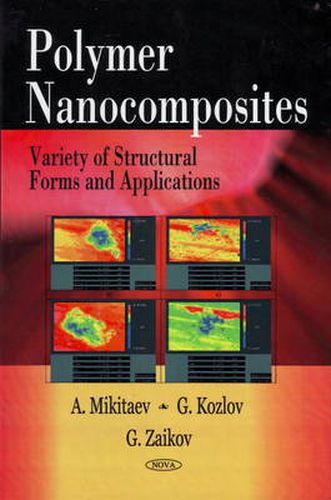Readings Newsletter
Become a Readings Member to make your shopping experience even easier.
Sign in or sign up for free!
You’re not far away from qualifying for FREE standard shipping within Australia
You’ve qualified for FREE standard shipping within Australia
The cart is loading…






Nanotechnologies development in various directions of science and engineering represents one of the most high-priority problems of modern science. One of such directions is the development and research of polymer nanocomposites with filler from nanoparticles and nanotubes possessing the increased strength and flame-resistance. In the last decade in the world literature a large amount of works have appeared which are dedicated both to technological and fundamental problems of polymer nanocomposites creation. The main part of these works adduced studies of polymer nanocomposites structure and properties, in which as filler organoclays with particles size of nanometre scale (for example, Na+-montmorillonite) were applied as a filler. Key studies in this field mainly use various kinds of modifications of large micromechanical models, created at one time for the description of polymer composites properties in general. These modifications are cumbersome enough, and mainly use complex computer technologies and although with their help convincing enough results were obtained, one should pay attention on their narrowness. In present quite many classes of polymer nanocomposites are obtained, having different reinforcement mechanisms, but the general ones in the sense, that these mechanisms are realised at the expense of introduction in polymer matrix particles of nanometre sizes. As it is known, the main peculiarity of such particles is a sharply increased polymer-filler contact area in comparison with usual fillers of micron scale size, that gives maximum reinforcement effect at small nanofiller contents. Hence it follows, that the main research object in the given case should be interfacial phenomena on polymer matrix-filler boundary, to which Academician Lipatov pointed as long as 40 years ago. Another important postulate is the fractal nature of nanoparticles structure, defining the mentioned above interfacial interactions level. The two postulates mentioned would be the main at the structure and properties of polymer nanocomposites analysis in the present monograph. At the same time the authors do not exlude the application of other model representations, for example, of the mentioned above micromechanical models.The purpose of the present monograph is the research of structure-properties relationships, defining a polymer nanocomposites reinforcement mechanism, for seven different classes of these materials. For these tasks solution the modern physical conceptions: synergetics of solid body, cluster model of polymers amorphous state structure, percolation theory are used.
$9.00 standard shipping within Australia
FREE standard shipping within Australia for orders over $100.00
Express & International shipping calculated at checkout
Nanotechnologies development in various directions of science and engineering represents one of the most high-priority problems of modern science. One of such directions is the development and research of polymer nanocomposites with filler from nanoparticles and nanotubes possessing the increased strength and flame-resistance. In the last decade in the world literature a large amount of works have appeared which are dedicated both to technological and fundamental problems of polymer nanocomposites creation. The main part of these works adduced studies of polymer nanocomposites structure and properties, in which as filler organoclays with particles size of nanometre scale (for example, Na+-montmorillonite) were applied as a filler. Key studies in this field mainly use various kinds of modifications of large micromechanical models, created at one time for the description of polymer composites properties in general. These modifications are cumbersome enough, and mainly use complex computer technologies and although with their help convincing enough results were obtained, one should pay attention on their narrowness. In present quite many classes of polymer nanocomposites are obtained, having different reinforcement mechanisms, but the general ones in the sense, that these mechanisms are realised at the expense of introduction in polymer matrix particles of nanometre sizes. As it is known, the main peculiarity of such particles is a sharply increased polymer-filler contact area in comparison with usual fillers of micron scale size, that gives maximum reinforcement effect at small nanofiller contents. Hence it follows, that the main research object in the given case should be interfacial phenomena on polymer matrix-filler boundary, to which Academician Lipatov pointed as long as 40 years ago. Another important postulate is the fractal nature of nanoparticles structure, defining the mentioned above interfacial interactions level. The two postulates mentioned would be the main at the structure and properties of polymer nanocomposites analysis in the present monograph. At the same time the authors do not exlude the application of other model representations, for example, of the mentioned above micromechanical models.The purpose of the present monograph is the research of structure-properties relationships, defining a polymer nanocomposites reinforcement mechanism, for seven different classes of these materials. For these tasks solution the modern physical conceptions: synergetics of solid body, cluster model of polymers amorphous state structure, percolation theory are used.